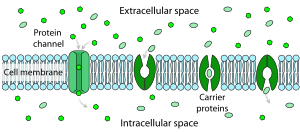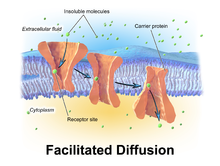Facilitated diffusion: Difference between revisions
m Reverted edits by 216.162.26.14 (talk) to last revision by Ethically Yours (HG) |
|||
| Line 15: | Line 15: | ||
Various attempts have been made by engineers to mimic the process of facilitated transport in synthetic (i.e., non-biological) membranes for use in industrial-scale gas and liquid separations, but these have met with limited success to date, most often for reasons related to poor carrier stability and/or loss of carrier from the membrane. |
Various attempts have been made by engineers to mimic the process of facilitated transport in synthetic (i.e., non-biological) membranes for use in industrial-scale gas and liquid separations, but these have met with limited success to date, most often for reasons related to poor carrier stability and/or loss of carrier from the membrane. |
||
Your not hellping you dont do your work right |
|||
== See also == |
== See also == |
||
Revision as of 16:45, 3 December 2013
This article needs additional citations for verification. (March 2010) |


- Not to be confused with diffusion. Facilitated diffusion is not a type of diffusion (thermal motion) but a type of transport process.
Facilitated diffusion (also known as facilitated transport or passive-mediated transport) is the process of spontaneous passive transport (as opposed to active transport) of molecules or ions across a biological membrane via specific transmembrane integral proteins.[1] Being passive, facilitated transport does not involve the use of chemical energy; rather, molecules and ions move down their concentration gradient. Facilitated diffusion is not a form of diffusion, however it is a transport process in which molecules or ions which would otherwise cross the membrane with great difficulty exploit transmembrane protein channels to help them cross this membrane.
Details
Polar molecules and charged ions dissolved in water cannot diffuse freely across the plasma membrane due to the hydrophobic nature of the fatty acid tails of phospholipids that make up the lipid bilayers. Only small non-polar molecules, such as oxygen can diffuse easily across the membrane. Hence, all polar molecules are transported across membranes by proteins that form transmembrane channels. These channels are gated, enabling them to open and close and thus regulating the flow of ions or small polar molecules. Larger molecules are transported by transmembrane carrier proteins, such as permeases that change their conformation as the molecules are carried through, for example glucose or amino acids. Non-Polar molecules, such as retinol or lipids are poorly soluble in water. They are transported through aqueous compartments of cells or through extracellular space by water-soluble carriers as retinol binding protein. The metabolites are not changed because no energy is required for facilitated diffusion. Only permease changes its shape in order to transport the metabolites. The form of transport through cell membrane which modifies its metabolites is the group translocation transportation.
Glucose, sodium ions and chloride ions are just a few examples of molecules and ions that must efficiently cross the plasma membrane but to which the lipid bilayer of the membrane is virtually impermeable. Their transport must therefore be "facilitated" by proteins that span the membrane and provide an alternative route or bypass.
Various attempts have been made by engineers to mimic the process of facilitated transport in synthetic (i.e., non-biological) membranes for use in industrial-scale gas and liquid separations, but these have met with limited success to date, most often for reasons related to poor carrier stability and/or loss of carrier from the membrane. Your not hellping you dont do your work right
See also
References
- ^ Pratt, Charlotte Amerley; Voet, Donald; Voet, Judith G. (2002). Fundamentals of biochemistry upgrade. New York: Wiley. pp. 264–266. ISBN 0-471-41759-9.
{{cite book}}: CS1 maint: multiple names: authors list (link)
2. {http://www.biology-online.org/dictionary/Facilitated_transport Facilitated Diffusion- Definition and Supplement}
